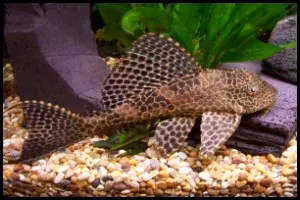

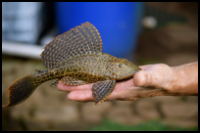
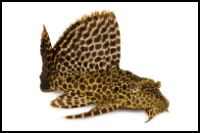
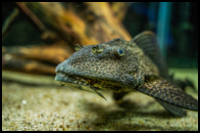
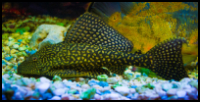
Quick Care Details (Table)
| Livestock Characteristics | Value |
|---|---|
| Care Level | Easy |
| Temperament | Peaceful |
| Diet | Omnivore |
| Maximum Size | 18 Inches |
| Minimum Tank Size | 100 Gallons |
| Plant Safe | Yes |
| Temperature Range | 72-82°F |
| PH Range | 6.5-7.5 pH |
| KH Range | 2-10 dKH |
| GH Range | 6-15 dGH |
Species Specific Categories
Helpful Video
Care Details
Aquascape
- Provide a spacious aquarium with plenty of open swimming space for your fish.
- Incorporate driftwood, rocks, and caves to create hiding spots for the pleco in your aquarium to hide.
- Use live or artificial plants in your tank, as well as algae-covered surfaces, for grazing and shelter.
- Avoid sharp decorations in your aquarium that could harm the pleco or damage its sail-like dorsal fin.
Substrate
- Use a soft, sandy substrate to mimic the natural riverbed where the pleco sifts for food.
- Avoid sharp or coarse aquarium substrates that could injure the pleco's delicate underbelly.
Disease Prevention
- Quarantine new fish before introducing them to the main tank to prevent potential diseases.
- Maintain excellent water quality through regular freshwater changes and proper filtration in your tank for proper fish care.
- Avoid overstocking fish in the aquarium to reduce stress and minimize disease transmission in your aquarium.
- Provide a balanced diet and ensure the pleco's nutritional needs are met to boost its immune system.
Filtration
- Choose a robust and efficient filtration system suitable for the tank's size and bioload.
- Include mechanical, biological, and chemical filtration to maintain water clarity and quality for your aquarium.
- Regularly clean and replace filter media to prevent clogging and maintain efficiency.
- Consider adding a pre-filter sponge to protect the pleco from getting stuck in the intake.
Lighting
- Sailfin plecos don't have specific lighting requirements, but it's essential to provide a natural day-night cycle.
- Use a timer to ensure consistent light exposure, typically 8-12 hours per day.
- Consider adding some low-intensity lighting to allow for viewing during nighttime.
Water Flow
- Sailfin plecos appreciate gentle to moderate water flow, simulating their natural river habitats.
- Use powerheads or adjustable pumps to create currents, but avoid strong currents that may stress the fish.
- Position the filter outlets strategically to ensure proper circulation throughout the aquarium.
Hardiness
- The Sailfin pleco is generally a hardy fish, but their health depends on suitable tank conditions.
- They can tolerate a range of freshwater parameters, but it's best to keep water quality stable and within optimal parameters.
- Regularly monitor water parameters, including temperature, pH, ammonia, nitrite, and nitrate levels.
- Provide a balanced diet to maintain the pleco's overall health and well-being.
Temperament and Behavior
Behavior and Social Interaction
- The Sailfin plecos is generally a peaceful and solitary fish, especially when they are young.
- As they mature, they may become more territorial, particularly males.
- They are primarily nocturnal, meaning they are more active during the night and tend to rest or hide during the day.
- The Sailfin pleco is an excellent algae eater and spend a significant portion of their time grazing on various surfaces.
Aggression
- Sailfin plecos are not typically aggressive towards other fish. However, territorial behavior might arise, especially during breeding or if space is limited.
- They may use their sail-like dorsal fin to display dominance or establish territory.
Breeding
- Breeding the sailfin pleco in captivity can be challenging due to their large size and specific breeding requirements.
- These fish are egg layers, and successful breeding often requires replicating natural conditions and providing suitable spawning sites, such as caves or crevices.
- After spawning, adult sailfin plecos do not show any parental care, so it's crucial to remove the eggs or fry from the main tank to protect them from potential fish predation.
Compatibility
- Sailfin plecos are generally compatible with a variety of community fish, especially those that are peaceful and non-aggressive.
- They are bottom-dwelling fish, so they usually don't interfere with mid-water or surface-dwelling species.
- Avoid keeping them with aggressive or fin-nipping fish that might harm their sensitive fins.
Activity Level
- Sailfin plecos are moderate to low activity fish during the day, often seeking shelter or staying hidden.
- They become more active during the night when they come out to graze on algae and other plant matter.
Clean-up Crew
- The Sailfin pleco is an excellent "clean-up crew" member in aquarium as they help control algae growth.
- They will graze on algae growing on glass, rocks, plants, and decorations, keeping the aquarium environment more aesthetically pleasing.
Schooling or Shoaling Behavior
- Sailfin plecos do not exhibit schooling or shoaling behavior.
- They are solitary fish and prefer to have their own space rather than staying in groups.
Diet and Nutrition
Dry Foods
- Dry foods, such as algae wafers and sinking pellets, are suitable staples for a sailfin pleco.
- Look for high-quality products with a balanced nutritional profile, including plant matter and protein.
- Choose sinking varieties, as plecos are primarily bottom-dwellers and prefer feeding near the substrate.
Frozen Foods
- Sailfin plecos can enjoy frozen foods like brine shrimp, daphnia, or bloodworms.
- Frozen foods provide additional variety and nutrition to their diet.
- Thaw frozen foods before feeding to avoid digestive issues.
Live Foods
- While not essential, sailfin plecos may occasionally enjoy live foods like brine shrimp, daphnia, or blackworms.
- Live foods can stimulate natural feeding behavior and provide enrichment.
Vegetables
- Vegetables are essential for the health of your sailfin pleco as they are herbivorous fish.
- Offer blanched vegetables like zucchini, cucumber, spinach, or kale.
- Remove any uneaten vegetables after a few hours to maintain water quality.
Algae
- Algae is a natural part of the sailfin pleco's diet, and they will graze on algae-covered surfaces in the aquarium.
- While they eat some algae, it's essential to supplement their diet with other foods to ensure proper nutrition.
Feeding Schedule
- Feed adult sailfin plecos once a day in the evening or at night, as they are primarily nocturnal feeders.
- Juvenile sailfin plecos might benefit from two small feedings daily.
- Monitor their feeding habits to avoid overfeeding and maintain good water quality.
Supplemental Foods
- Consider using specialized sinking pellets or tablets that contain additional nutrients, such as spirulina, for optimal health.
- Incorporate vitamin-rich supplements occasionally to enhance their diet and overall well-being.
- Ensure the supplemental foods are suitable for omnivores fish like a sailfin pleco.
Tank Parameters
Tank Size
- For juvenile sailfin plecos (up to 4-5 inches), a tank size of around 50 gallons is suitable.
- As they grow, adult sailfin plecos will require a much larger tank.
- For fully-grown adult sailfin plecos, a tank size of at least 100 gallons or more is recommended to provide ample swimming space.
Tank Length and Measurements
- Aim for a tank length of at least 48 inches (4 feet) or more to accommodate the sailfin pleco's elongated body comfortably.
- A longer tank provides more swimming space and ensures that the pleco can turn and move around freely.
The Species Maximum Size
- Sailfin plecos can grow quite large, reaching up to 12 to 18 inches (30 to 45 centimeters) in length.
- Providing enough space and appropriate tank size is essential to accommodate their eventual size.
Water Temperature
- The ideal water temperature for sailfin plecos ranges between 72°F to 82°F (22°C to 28°C).
- Keep the temperature stable, avoiding drastic fluctuations, which can stress the fish.
pH (Acidity/Alkalinity)
- Sailfin plecos prefer a slightly acidic to neutral pH level in the range of 6.5 to 7.5.
- Aim to keep the pH stable within this range to promote a healthy environment.
KH (Carbonate Hardness)
- Carbonate hardness helps stabilize the pH in the aquarium.
- For sailfin plecos, a KH of 2 to 10 dKH is suitable.
GH (General Hardness)
- The Sailfin pleco can tolerate a moderate to high general hardness.
- A GH range of 6 to 15 dGH is generally acceptable for these fish.
Nitrate (NO3) Levels
- Keep nitrate levels in the aquarium as low as possible, ideally below 20 ppm (parts per million).
- Regular water changes and proper filtration are essential to control nitrate buildup.
History, Popularity, History and Species Variety Details
The History, Popularity and Habitat of the Sailfin Pleco
History: The sailfin pleco, scientifically known as Pterygoplichthys gibbiceps, is a species of freshwater fish belonging to the family Loricariidae. It is native to the South American continent, specifically found in the Amazon River basin and its various tributaries. The genus Pterygoplichthys comprises several other pleco species, and sailfin plecos are among the most popular and well-known members.
Sailfin plecos have been in the aquarium hobby for several decades, and their popularity continues to grow due to their unique appearance and useful algae-eating abilities. They were first introduced to the aquarium trade in the mid to late 20th century, and since then, they have become a common sight in many freshwater aquariums around the world.
Popularity: The sailfin pleco's popularity stems from its striking appearance and practical benefits for aquarium hobbyists. Their large sail-like dorsal fin and leopard-like spots make them visually appealing, catching the eyes of enthusiasts and beginners alike. Additionally, their algae-eating habits have earned them the nickname "algae eater," which is a highly desired trait for keeping aquariums clean and well-maintained.
Being peaceful and generally compatible with various community fish adds to their appeal as they can coexist with other non-aggressive tankmates. Moreover, their herbivorous diet makes them a valuable addition to planted tanks, where they help control algae growth while having a minimal impact on the live plants.
Due to their larger size and potential for territorial behavior as they mature, it's essential for keepers to understand their care requirements fully. Despite this, dedicated aquarists appreciate sailfin plecos for their unique characteristics, making them a sought-after species in the aquarium hobby.
Habitat: In their native habitat of South America, sailfin plecos are found in the vast Amazon River basin, which covers parts of Brazil, Peru, Colombia, and other neighboring countries. Within this extensive region, they inhabit slow-moving or stagnant waters, such as rivers, streams, and oxbow lakes. These water bodies are rich in vegetation, providing ample opportunities for the sailfin pleco to graze on algae and other plant matter.
Sailfin plecos are well-adapted to their environment, with their specialized sucker mouth allowing them to cling to surfaces like rocks, driftwood, and aquatic plants. They use this feature to forage for food and find shelter. Their sail-like dorsal fin is believed to serve as a mechanism for territorial displays or communication among conspecifics.
In aquariums, replicating some aspects of their natural habitat is crucial for their well-being. Providing ample hiding spots, such as caves and crevices, allows them to feel secure, while driftwood and rocks mimic their natural foraging and sheltering sites. A well-maintained environment with suitable water parameters and a varied diet will ensure that the sailfin pleco thrives in captivity.
Back to topPterygoplichthys Pleco Types
- Pterygoplichthys gibbiceps - Also known as the Leopard Sailfin Pleco, this is one of the most common and popular species in the aquarium trade. It has a striking appearance with a large, sail-like dorsal fin and a leopard-like spotted pattern on its body.
- Pterygoplichthys pardalis - Known as the Amazon Sailfin Pleco or Janitor Fish, this species is similar in appearance to P. gibbiceps but has a more pronounced spotted pattern.
- Pterygoplichthys multiradiatus - The Orinoco Sailfin Pleco or Vermiculated Sailfin Pleco is another popular species in the hobby. It has a unique coloration with dark bands and a more intricate spotted pattern on its body.
- Pterygoplichthys disjunctivus - Often referred to as the Vermiculated Sailfin Pleco, this species is characterized by a mix of dark bands and intricate markings on its body, resembling a vermiculated pattern.
- Pterygoplichthys joselimaianus - The Sultan Pleco or L001 is a less common species with a dark body covered in small, white spots.
- Pterygoplichthys punctatus - Known as the Spotted Sailfin Pleco or Common Pleco, this species is smaller in size compared to others in the genus and has distinctive dark spots on a light background.
- Pterygoplichthys ambrosettii - Also known as the Orinoco Angel Pleco, this species has a beautiful coloration with a silver background and dark spots covering the body.
Common Fish Tank mates
- Peaceful Community Fish
- Many peaceful community fish can be kept alongside sailfin plecos, such as tetras, rasboras, gouramis, platies, mollies, and peaceful barbs.
- Corydoras Catfish
- Other species of small to medium-sized peaceful catfish, like various Corydoras species, can be excellent companions for sailfin plecos.
- Other Plecos
- Some other species of smaller plecos can coexist with sailfin plecos in a larger aquarium. Just be cautious about keeping multiple large plecos together, as territorial issues may arise.
- Bristlenose Plecos
- Bristlenose plecos (Ancistrus species) are a popular choice to keep with sailfin plecos. They are smaller and less likely to compete for space.
- Dwarf Cichlids
- Peaceful dwarf cichlids like Apistogramma and Mikrogeophagus (German Blue Rams) can work well in a community aquarium with sailfin plecos.
- Larger Tetra Species
- Larger tetras like Serpae Tetras or Emperor Tetras can be compatible tank mates with sailfin plecos.
- Rainbowfish
- Some species of rainbowfish, like Boesemani Rainbowfish, can be suitable companions for sailfin plecos.
- Giant Danios
- Giant Danios (Devario aequipinnatus) are active, fast-swimming fish that are compatible with sailfin plecos.
- Giant Gourami
- Giant Gouramis (Osphronemus goramy) can be suitable companions in large aquariums with ample space.
- Angelfish
- Angelfish (Pterophyllum scalare) are generally peaceful and can work well with sailfin plecos in larger community tanks.
- Silver Dollar Fish
- Silver Dollar Fish (Metynnis species) are peaceful schooling fish that can be compatible with sailfin plecos.
- Rainbow Shark
- The Rainbow Shark (Epalzeorhynchos frenatum) can be a suitable tank mate as long as there is enough space and hiding spots.
Male gender vs Female gender (Sexual Dimorphism)
- Observe the size and shape: In general, male sailfin plecos tend to be larger than females, with a more elongated body shape. They may also have a broader and more muscular head region.
- Check the fin ray extension: Male sailfin plecos typically have longer and more extended dorsal and pectoral fins compared to females. The fins of females are usually shorter and more rounded.
- Examine the bristles on the head: Sailfin plecos have a series of bristles on their heads, known as odontodes. Males often have more pronounced and longer bristles on the leading edge of their pectoral fins, the snout, and the head area compared to females.
- Look for a genital papilla: In sexually mature males, there will be a small, finger-like projection known as a genital papilla, located just behind the anus. This is not typically present in females.
- Observe behavior during breeding: During the breeding season, males may become more territorial and aggressive, displaying courting behaviors like cleaning potential nesting sites and attempting to attract females.
- Consider the fish's age: Sexual dimorphism becomes more apparent as the fish mature. If the sailfin plecos are still juveniles, it might be challenging to determine their gender accurately.
- Compare with other sailfin plecos: If you have access to multiple sailfin plecos, observing and comparing their physical characteristics can sometimes help in identifying gender differences.
Breeding
- Prepare a suitable tank: Set up a separate breeding tank that is spacious enough for the plecos and replicates their natural environment. A tank size of at least 75 gallons or more is recommended, as these fish can grow large. The tank should have excellent filtration and aeration to maintain water quality.
- Create hiding spots: Provide plenty of hiding spots like caves, PVC pipes, or driftwood. These hiding spots are essential for the plecos to feel secure and to serve as potential nesting sites.
- Condition the breeders: Make sure the male and female plecos are in excellent health and well-fed before attempting to breed them. Provide a varied diet that includes high-quality sinking pellets, fresh vegetables like zucchini or cucumber, and occasional live or frozen foods like bloodworms or brine shrimp.
- Monitor water parameters: Sailfin plecos prefer slightly acidic to neutral water conditions. Maintain the water temperature around 76-82°F (24-28°C), pH between 6.5 to 7.5, and water hardness between 5 to 15 dGH.
- Introduce the pair: Place one male and one female pleco into the breeding tank. Ensure that they have established hiding spots to reduce stress.
- Observe breeding behavior: Breeding behavior may take some time to start, and it typically occurs during the rainy season. Males may become territorial, cleaning surfaces, and preparing potential nesting sites.
- Look for signs of courtship: Males may swim around the female, showing off their bristles and extended fins. They might also chase the female around the tank during courtship.
- Egg deposition and fertilization: When the female is ready to spawn, she will lay her eggs inside a chosen nesting site (cave or other hiding spot). The male will follow and fertilize the eggs by releasing milt.
- Remove the adults: After the eggs are laid and fertilized, it's best to remove the adult plecos from the breeding tank to prevent them from eating the eggs or fry.
- Incubation period: The eggs will hatch within a few days, and the fry will absorb their yolk sac for nourishment initially. Once they become free-swimming, you can start feeding them with infusoria, powdered spirulina, or commercial fry food.
- Fry care: Provide plenty of hiding spots and very gentle filtration in the fry tank. Keep the water clean and maintain good water quality. As they grow, you can gradually introduce larger foods like baby brine shrimp and finely crushed flakes or pellets.
Back to top
Frequently Asked Questions
What is a sailfin pleco?
The sailfin pleco (Pterygoplichthys gibbiceps) is a freshwater fish species belonging to the family Loricariidae. It is native to South America and is popular in the aquarium trade for its unique appearance and algae-eating habits.
How big do sailfin plecos grow?
Sailfin plecos can grow quite large, reaching up to 12 to 18 inches (30 to 45 centimeters) in length when fully mature.
What should I feed my my pleco?
Sailfin plecos are primarily plant eaters and should be fed a diet that includes algae wafers, sinking pellets, and fresh vegetables like zucchini or cucumber. They can also consume live and frozen foods occasionally.
What tank size is suitable for sailfin plecos?
For juvenile sailfin plecos (up to 4-5 inches), a tank size of around 50 gallons is suitable. A fully-grown sailfin pleco adult will require a tank size of at least 100 gallons or more to accommodate their size.
Are sailfin plecos aggressive?
Sailfin plecos are generally peaceful, but they can become territorial, especially as they mature. It's essential to provide enough space and hiding spots to minimize fish aggression.
Can sailfin plecos be kept with other fish?
Sailfin plecos are generally compatible with a variety of community fish, especially peaceful and non-aggressive species. Avoid keeping them with aggressive or fin-nipping fish.
How often should I feed my pleco?
Adult sailfin plecos should be fed once a day in the evening or at night, while juveniles might benefit from two small feedings daily. Monitor their feeding habits to avoid overfeeding.
Can these plecos be kept with live plants in the aquarium?
Yes, sailfin plecos can be kept with live plants in the aquarium. However, this fish may occasionally graze on tender plant leaves, so choose hardier plant species.
Can I breed these plecos in my aquarium?
Breeding sailfin plecos in captivity can be challenging due to their large size and specific breeding requirements. Successful breeding this fish may require replicating natural conditions and providing suitable spawning sites.
What is the difference between a sailfin and a common pleco?
Sailfin plecos (Pterygoplichthys gibbiceps) and common plecos (Hypostomus plecostomus) are popular aquarium fish, but they differ in size, appearance, temperament, and habitat preferences. Sailfin plecos are larger, reaching up to 18-20 inches, with an elongated body and a prominent sail-like dorsal fin. They have a darker base color with spots and bristles on their head and fins. Common plecos, on the other hand, grow up to 12-24 inches, have a more typical pleco appearance with a rounder body and flattened head. They are usually solid dark brown or black with lighter spots. Sailfin plecos are known for their preference for algae and plant matter, while common plecos are more opportunistic scavengers, consuming various types of organic matter. Both species require ample space and care, with common plecos being more aggressive as they grow larger.

